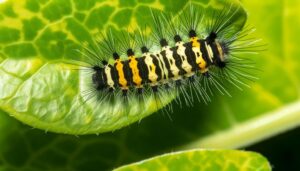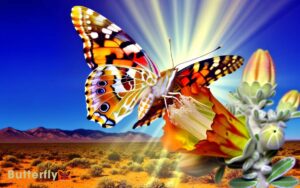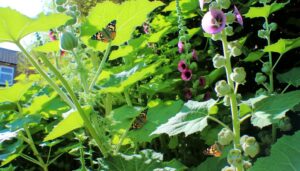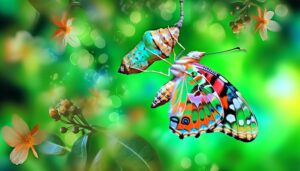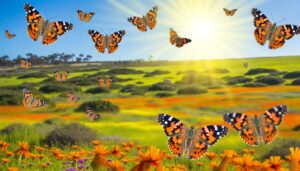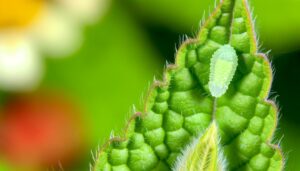Painted Lady Butterflies in Iowa: Discover Their Journey!
The Painted Lady butterfly, Vanessa cardui, frequents Iowa with its striking orange and black wings punctuated by white spots.
Boasting a wingspan of 2 to 2.9 inches, this species undergoes a complete metamorphosis from egg to adult. They initiate extensive migrations from North America to Central America, propelling their population movements through Iowa.
Preferring sunny meadows and gardens with nectar-rich flowers like thistles, they contribute greatly to pollination. Their presence supports local biodiversity by aiding plant reproduction and serving as food for various species.
For those interested in ensuring higher local populations, there’s more to uncover.
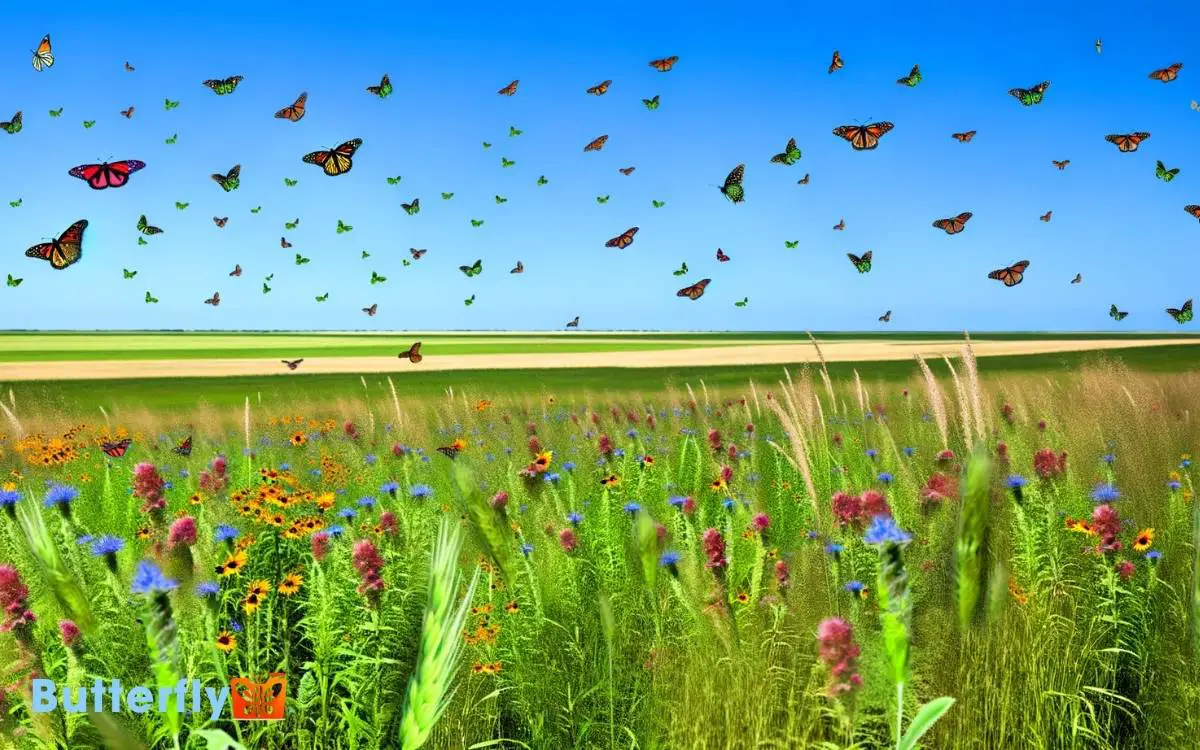
Key Takeaways
Identification and Characteristics
The Painted Lady butterfly, scientifically known as Vanessa cardui, can be identified by its distinctive orange and black patterned wings adorned with white spots. These striking patterns serve as a key identification marker, helping differentiate it from other species.
Its wingspan ranges from 2 to 2.9 inches, making it a medium-sized butterfly. The underside of the wings displays a more muted palette, with brown and gray hues, featuring small eyespots that aid in camouflage.
Antennae are clubbed, typical of butterflies, and their bodies are covered in fine scales. Vanessa cardui’s proboscis is specially adapted for nectar feeding, allowing it to thrive in various habitats.
Understanding these characteristics aids in accurate identification in the field.
Life Cycle Stages
One can witness Vanessa cardui undergoing a fascinating transformation through its four distinct life cycle stages: egg, larva, pupa, and adult.
The cycle starts with a tiny, greenish egg, often laid on thistle leaves. Upon hatching, the larva (caterpillar) emerges, displaying distinctive black and yellow bands.
This stage is essential for feeding and growth. It then forms a chrysalis (pupa), a suspended, immobile stage where metamorphosis occurs internally.
Finally, the adult butterfly emerges, showcasing vibrant orange and black wings, ready to mate and lay eggs, perpetuating the cycle.
| Stage | Description | Key Feature |
|---|---|---|
| Egg | Tiny, greenish, on thistle leaves | Initiates the life cycle |
| Larva | Black and yellow bands | Intensive feeding and growth phase |
| Pupa | Chrysalis, immobile | Metamorphosis occurs internally |
This detailed observation of the life cycle stages provides insight into the complex development of the Painted Lady butterfly.
Migration Patterns
Frequently, Painted Lady butterflies in Iowa undertake remarkable long-distance migrations, showcasing one of the most extensive and complex migratory behaviors observed in insects. These butterflies travel thousands of miles, navigating changing weather conditions and seasonal shifts with remarkable precision. Scientists have observed that painted lady butterflies in South Dakota follow similar migration patterns, often moving northward in the spring and returning south as temperatures drop. Their journey plays a crucial role in maintaining ecological balance by aiding in pollination and serving as a food source for various predators.
These migrations can span thousands of miles, with butterflies traveling from North America to Central America and back. The journey is driven primarily by seasonal changes and the availability of host plants for their larvae. Utilizing prevailing winds, they can cover significant distances efficiently.
Curiously, their migration is multigenerational; no single butterfly completes the entire round trip. Instead, successive generations continue the journey, with each stage of the life cycle occurring along different parts of the migratory route.
This behavior safeguards the species’ survival despite varying environmental conditions and resource availability across regions.
Habitat Preferences
As Painted Lady butterflies traverse their intricate migratory routes, they display distinct habitat preferences that guarantee ideal conditions for feeding, mating, and laying eggs.
They favor open, sunny areas such as meadows, fields, and gardens rich in nectar-producing flowers like thistles, asters, and sunflowers.
These habitats provide essential resources, including host plants like mallow, hollyhock, and legumes, for their larvae. They also prefer environments with minimal pesticide exposure, ensuring higher survival rates.
The availability of these specific plants and environmental conditions shapes their distribution patterns across Iowa.
Additionally, Painted Ladies are adaptable, allowing them to exploit a wide range of habitats, including disturbed or urban spaces, as long as their critical ecological needs are met.
Role in Pollination
Painted Lady butterflies play an essential role in pollination by transferring pollen as they move from flower to flower in search of nectar, thereby contributing to the reproductive success of a wide variety of plant species.
Their proboscis, adapted for extracting nectar, inadvertently picks up pollen grains, facilitating cross-pollination. This process enhances genetic diversity and improves plant resilience.
They frequent diverse floral habitats, including meadows, gardens, and roadside vegetation, ensuring widespread pollination.
The butterflies’ migratory behavior further extends their pollination services across vast geographic regions. Detailed studies indicate they prefer open, sunny environments rich in flowering plants.
Painted Ladies’ efficient pollination mechanisms make them indispensable for sustaining both agricultural crops and native flora, underscoring their ecological importance in Iowa’s ecosystems.
Impact on Biodiversity
The presence of Painted Lady butterflies greatly enriches Iowa’s biodiversity by supporting a variety of plant and animal species through their pollination activities and serving as a food source for predators.
Their pollination efforts benefit numerous flowering plants, enhancing genetic diversity and ecosystem resilience. This activity is essential for maintaining the health of native flora, which in turn supports a range of herbivores and higher trophic levels.
Additionally, Painted Lady larvae serve as an important food source for birds, small mammals, and other insects, playing a key role in the food web. Their migratory behavior introduces genetic variation, which can prevent inbreeding depression in local populations.
Encouraging Local Populations
To encourage local populations of Painted Lady butterflies in Iowa, individuals can plant native wildflowers that provide essential nectar sources.
Reducing pesticide usage is also vital, as these chemicals can harm both the butterflies and their larvae.
Plant Native Wildflowers
Planting native wildflowers significantly boosts local populations of Painted Lady butterflies by providing essential nectar sources and suitable habitats for their larvae.
Native species like milkweed, coneflowers, and goldenrods are particularly beneficial. These plants offer high-quality nectar that sustains adult butterflies during their active periods.
Additionally, native wildflowers support the lifecycle of Painted Lady larvae by supplying appropriate host plants for egg-laying and caterpillar nourishment. This symbiotic relationship guarantees the butterflies can thrive and reproduce effectively.
Observations indicate that areas rich in native wildflowers exhibit higher densities of Painted Lady butterflies.
Consequently, cultivating native flora not only supports the butterflies but also contributes to overall ecosystem health by promoting biodiversity and stabilizing local food webs.
Reduce Pesticide Usage
Reducing pesticide usage further encourages robust local populations of Painted Lady butterflies by minimizing exposure to harmful chemicals that can disrupt their lifecycle and habitats.
Pesticides, particularly broad-spectrum types, can inadvertently kill non-target species, including these butterflies. By limiting pesticide application, the ecosystem becomes more balanced, allowing natural predators to control pests.
To effectively reduce pesticide usage, consider the following:
- Integrated Pest Management (IPM): Utilize biological controls and cultural practices to manage pest populations.
- Selective Targeting: Apply pesticides only when necessary and choose products that target specific pests, minimizing collateral damage.
- Organic Alternatives: Employ organic pesticides, which are generally less harmful to non-target species and degrade more quickly.
Implementing these strategies can create a safer environment for Painted Lady butterflies in Iowa.
Conclusion
Ironically, while the painted lady butterfly‘s beauty captivates Iowans, it’s their unassuming role in pollination and biodiversity that’s truly significant.
Their complex life cycle and arduous migrations are a proof of their resilience. Yet, despite their important ecological contributions, they’re often overshadowed by more ‘glamorous’ species.
Encouraging local populations isn’t just about aesthetics; it’s a nod to their pivotal role in Iowa’s ecosystem. So, perhaps these modest creatures deserve a bit more of our admiration.

